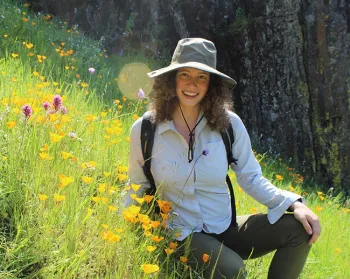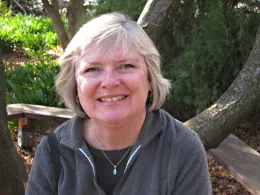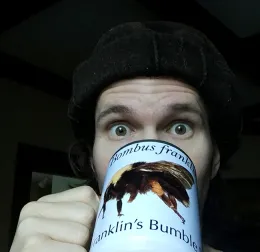It's a Tie: Two Scientists Co-Win the Second Annual Bumble-Bee-of-the-Year Contest

Game over.
The second annual Robbin Thorp Memorial First-Bumble Bee-of-the-Year Contest is over.
On two separate expeditions, but at exactly 2:30 p.m., Saturday, Jan. 1, UC Davis doctoral candidate Maureen Page of the Neal Williams lab, UC Davis Department of Entomology and Nematology, and horticulturist Ellen Zagory, retired director of public horticulture for the UC Davis Arboretum and Public Garden, co-won the contest by each photographing a bumble bee foraging on manzanita (Arctostaphylos) in the 100-acre Arboretum.
Fittingly, they both knew and worked with Robbin Thorp (1933-2019), a global authority on bees and a UC Davis distinguished emeritus professor of entomology.
The event also marked the second consecutive year that a member of the Williams lab scored a win. Last year postdoctoral researcher Charlie Casey Nicholson of the Williams lab and the lab of Elina Lastro Niño, claimed the prize by photographing a B. melanopygus at 3:10 p.m., Jan. 14 in a manzanita patch in the Arboretum.
Contest coordinator Lynn Kimsey, director of the Bohart Museum of Entomology, sought the first bumble bee of the year in the two-county area of Yolo and Solano in memory of Thorp, a 30-year member of the UC Davis faculty. Thorp retired in 1994 but continued his work until several weeks before his death at age 85 at his home in Davis. Every year he looked forward to seeing the first bumble bee.

Page began looking for the bumble bee in the Arboretum on Dec. 31. “I went on a walk through the UC Davis Arboretum at 3 p.m. on New Year's Eve and stopped by a manzanita tree hoping to see a bumble bee,” recounted Page. “After less than a few minutes, I spotted a black-tailed bumble bee, Bombus melanopygus! However, it was not yet 2022 so I planned to return the following day at 2 p.m. and was similarly lucky--I spotted a bee within minutes of arriving. It was sunny and about 50 degrees Fahrenheit outside when I observed the bumble bee." Bombus melanopygus is the earliest bumble bee species to emerge in this area.
"Although I saw the bee within a few minutes of arriving, I spent an hour trying to get a good photograph," Page said. "In the process of trying to photograph the bee, I saw at least one other Bombus melanopygus visiting manzanita flowers!" She captured the image with her cell phone.

Professor and pollinator ecologist Neal Williams identified the bee image that Zagory took as a yellow-faced bumble bee, Bombus vosnesenskii, but indicated it is way early for this bumble bee to emerge in this area.
Both Zagory and Page and worked with Robbin Thorp, a tireless advocate of pollinator species protection and conservation and the co-author of Bumble Bees of North America: An Identification Guide (Princeton University, 2014) and California Bees and Blooms: A Guide for Gardeners and Naturalists (Heyday, 2014).
“I indeed knew Robbin Thorp, one of the most generous and kind people I have ever met,” Zagory said. “Dr. Thorp invited me to do a page for their book (California Bees And Blooms: A Guide for Gardeners and Naturalists) about the UC Davis Arboretum All-Stars (pages 230 -232) and he edited a publication we created at the UC Davis Arboretum called Ten Bees and Ten Plants they Love that can be downloaded from the web site at https://arboretum.ucdavis.edu/pollinator-gardening.
Both Page and Nicholson are alumni of The Bee Course, which Thorp co-taught from 2002-2018. Page took the course in 2018, and Nicholson in 2015. The nine-day intensive workshop, geared for conservation biologists and pollination ecologists and considered the world's premiere native bee biology and taxonomic course, takes place annually in Portal, Ariz. at the Southwestern Research Station, part of the American Museum of Natural History, N.Y.
Page said she was “also lucky enough to participate in a "Bumble Bee Blitz" organized by Thorp and the U. S. Fish and Wildlife Service in July 2016 on Mt. Ashland, where we searched for Bombus franklini and Bombus occidentalis-- two very rare west coast bee species. We unfortunately did not find Bombus franklini, which is now recognized as an endangered species under the Endangered Species Act.”
“Robbin was a brilliant scientist and a dedicated advocate for bumble bee conservation,” Page said. “His death was a great loss and I wish more of my career could have overlapped with his time in Davis.”
As a doctoral candidate in entomology, Page researches and investigates “whether European honey bees compete with native bees for floral resources and how we can use well-planned floral enhancements to mitigate negative effects of competition."
She and Nicholson are the co-leading authors of "A Meta-Analysis of Single Visit Pollination Effectiveness Comparing Honeybees and Other Floral Visitors," the Nov. 30th cover story in the American Journal of Botany. Citing the importance of native bees, Page said: "Native bees provide irreplaceable pollination services. I'm glad to see that flower plantings, like those found in the UC Davis Arboretum, provide food for diverse native bee communities as early as Jan. 1.”
